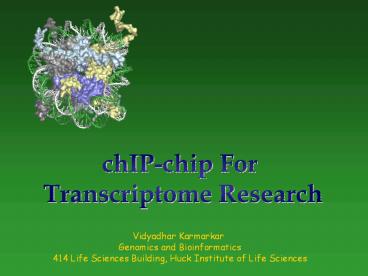chIP-chip For - PowerPoint PPT Presentation
1 / 22
Title: chIP-chip For
1
chIP-chip For Transcriptome Research
Vidyadhar Karmarkar Genomics and
Bioinformatics 414 Life Sciences Building, Huck
Institute of Life Sciences
2
Chromosomal Packaging
Chromatin
- 2.9 million bp in haploid human genome
- 1.5 human genome codes for proteins
- 20,000 human genes
Felsenfeld and Groudine (2003) Nature 421,
448-453
3
Gene Structure
4
Transcription A quick review
http//www.msu.edu/course/lbs/ 145/smith/s02/graph
ics/ campbell_17.7.gif
5
Single TF-Multiple Responses
Hanlon and Lieb (2004) Curr. Opin. Gen. Dev.
14697-705
6
Transcriptome Research
chIP-chip
Microarrays
Traditional
Computational
Tag-based
7
Limitations of current methods in Transcriptome
Research
- Are in vitro and not in vivo
- Gel-shift assays poor predictors of TFs actual
binding site - Computational approaches frustrating
- DNA-footprinting and chIP-qtPCR reveals limited
information - -Buck and Lieb (2004) Genomics 83349-360
- RNA level measurement - an indirect indicator
- of TF activity Hanlon and Lieb (2004) Curr.
Opin. Gen. Dev. 14697-705
8
Basic steps in chIP
Fixation
Sonication
Immunoprecipitation
Analysis of IP-ed DNA
Das et al (2004) Biotechniques 37(6) 961-969
9
Advantages of chIP
- Information about in vivo location of TF binding
sites on the DNA - Captures information from living cells
- Powerful tool in genomics when coupled to cloning
and microarrays
Das et al (2004) Biotechniques 37(6) 961-969
10
chIP-chip
chIP
Das et al (2004) Biotechniques 37(6) 961-969
Buck and Lieb (2004) Genomics 83349-360
11
Summary of chIP-chip
- Employs the strategy of enriching the TF-target
sites by immunoprecipitating followed by
microarray to detect the level of enrichment
Sikder and Kodadek (2005) Curr. Opin. Chem. Biol.
938-45
12
Types of DNA microarrays
- Types
- Mechanically spotted cDNA/amplicons
- Mechanically spotted oligos
- In situ synthesis of oligos
- Most of these arrays made from
- transcribed genomic regions
Buck and Lieb (2004) Genomics 83349-360
13
Choosing chip for chIP
- Promoter region is not transcribed
- TF binding sites mapped
- Outside the predicted promoter region (Cawley et
al 2002 Genome Res. 121749-1755 Martone et al
2003 PNAS 10012247-12252 Euskirchen 2004 Mol.
Cell. Biol. 243804-3814) - In coding and non-coding regions (Martone et al
2003 PNAS 10012247-12252 Euskirchen 2004 Mol.
Cell. Biol. 243804-3814)
14
Choosing chip for chIP
- On separate arrays enrichment at any given spot
is relative to sequences on same array - Whole genome arrays reveals enrichment of ORFs
relative to intergenic regions
Hanlon and Lieb (2004) Curr. Opin. Gen. Dev.
14697-705
15
Maximizing TF-target identification
- Arrays that tile across an entire regulatory
region of interest (Horak et al 2002 PNAS
992924-2929) - Comprehensive but specific to the regulatory
region - Limited information
- CpG island microarray (Weinmann et al 2002 Genes
Dev 16235-244) - Less of primers gt reduced cost
- Unbiased coverage of large portion of genome
- Requires sequence information on identity of
clones - Low cost but highly informative option to whole
genome arrays
16
Maximizing TF-target identification
- DNA tiling arrays (whole genome arrays)
representing all intergenic regions and predicted
coding sequences (Iyer et al 2001 Nature
409533-538) - - Successfully used in yeast (Buck and Lieb 2004
Genomics 83349-360) - Costly and technically challenging to make in
organisms with large genomes
17
Computational Validation of chIP-chip data
- Resolution of chIP-chip within 1-2 kb and exact
site of DNA-protein interaction unknown - Programs to analyze chIP-chip data
- MDScan (Liu et al 2002 Nature Biotech.
20835-839) - MOTIF REGRESSOR (Conlon et al 2003 PNAS 100
(6)3339-3344)
18
Drawbacks of chIP-chip
- chIP is technically challenging
- Promiscuous crosslinking by formaldehyde
- Resolution dependant on
- Sheared DNA fragment size,
- length and spacing of arrayed DNA elements used
to detect IP elements - Cost of making arrays
Buck and Lieb (2004) Genomics 83349-360
19
Possible complications with chIP-chip
Differential formation of DNA-protein crosslinks
Variable epitiope accessibility
Legend
Hanlon and Lieb (2004) Curr. Opin. Gen. Dev.
14697-705
20
Normalization of chIP-chip data
Mistaking ubiquitous modification to be uniform
distribution
Mistaking promoter associated modification to be
uniform distribution
Hanlon and Lieb (2004) Curr. Opin. Gen. Dev.
14697-705
21
Conclusion
- chIP-chip is efficient method for TF-target
identification - Computational and biochemical validation of
chIP-chip data required to pinpoint the exact
site of TF-DNA interaction - chIP-CpG arrays are cost effective alternative to
chIP-WG arrays
22
Future Prospects
- Novel insights in genomics of pathogenesis,
development, apoptosis, cell cycle, genome
stability and epigenetic silencing, chromatin
remodelling - High-throughput method for genome annotation and
cross-validation of previous data































